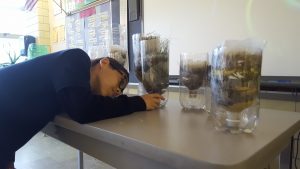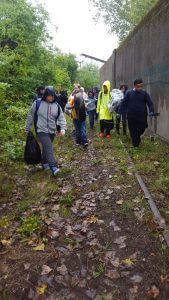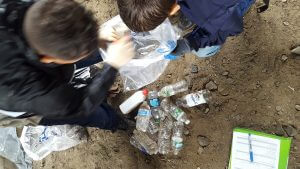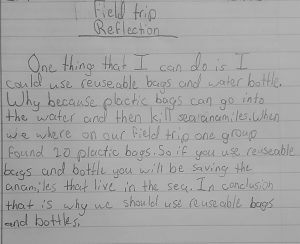5th Grade, McMahon Elementary School, Holyoke, MA
By Kristie McLaughlin, 5/6 Science Teacher

Evaluating effectiveness of water filters
Inquiry-based, place-based, problem-solving, and student-centered — these are ideals I hold as a teacher and work hard to integrate into my curriculum while adhering to every standard and practice. While I’ve not yet managed to hit every one of these markers with every unit I’ve ever designed for McMahon 5th and 6th grade students, when the fifth grade comes in for their first unit of science class ever, I’ve hit these markers. McMahon students are an incredibly diverse group of learners: newcomers from Puerto Rico; students in our Autism-inclusion program; students from stable families; and homeless students. My goal is to always develop curriculum that keeps the individual at the front and is naturally adaptable to the students’ needs, lessened to ensure ‘quality over quantity,’ or expanded to provide enrichment. My hope is that this initial introduction to see what science learning can be like will instill a lifelong love of science and nourish the natural curiosity that all children hold.

Clean up at Slim Shad Point, Holyoke, MA
The first fifth grade unit addresses Massachusetts Science Technology and Engineering and Next Generation Science Standards (NGSS) Earth Systems Standards 5-ESS2-1, 5-ESS2-2, 5-ESS3-1, and deliberately walks each student through every ‘practice’ as outlined by the NGSS, beginning with ‘asking questions and defining problems.’ Armed with Google Earth, a poster, and a cut out of a storm drain, a sink, and a raincloud, students are challenged to try to answer our unit’s guiding question: Where does my water come from? Where does it go? Each student placed their sink at a defined location in Holyoke — their home, the Y, our school, and then tried to figure out how that water got there and where it goes when it runs down the drain. From this initial virtual exploration of our city, students find where all the water is — Ashley Reservoir, a plethora of canals, the sewage treatment plant right off of Main Street, and of course the Connecticut River. From here on out we focus on the river.

Cleaning up trash in the rain, Holyoke, MA
We move onto ‘developing and using models,’ trying to build river valleys that mimic the shape of the Connecticut river on stream tables in our classroom, modeling the water cycle using the classic hot-pot and tray of ice model, reading about both the history of water pollution and how it led to the formation of the Clean Air and Water Act, and reading about contemporary issues in clean water. These include ongoing issues in Flint, MI, reading about schools that have unsafe water, reflecting on the sinks in our school that are unsafe to drink from because of high lead levels, and how microplastics are so pervasive in water around our country and our world. When we read about all these issues students can’t help but wonder what they can do to help.
“I have empathy and compassion for the children in Flint”
– from Edwin’s journal entry
NGSS Standard 5-ESS3-1 challenges students to describe a personal or community change that they can make to reduce the human impact on the environment. This year our unit culminated with participating in the Connecticut River Conservancy’s Source to Sea Cleanup. On a rainy Friday, 42 McMahon fifth graders got to finally got to visit the river they’d been studying since the second week of school and work to make a difference.

Sorting, counting, and taking trash tallies
Visiting the river touched on two practices outlined by the NGSS — “asking questions,” as adult volunteers encouraged the natural inquiry of children, as well as “analyzing data.” We tallied the trash that we found, and sorted bottles into returnables and non-returnables. We counted plastic bags, tires, metal scraps, and noted unusual or dangerous trash, such as used oil filters.

Field Trip Reflection
At McMahon School we have a focused writing initiative and my personal professional practice goal for SY 2018-19 as an educator is to focus on students being able to write better scientifically, using both scientific data and text evidence to support a claim. While writing can be seen as a chore, students were writing passionately about the change they could make: to start using reusable water bottles, to talk to their parents about using reusable shopping bags, to petition the state to put a deposit on plastic water bottles (“I notice my water bottle has some state deposits but not for MA; out of 45 plastic bottles we collected, only 5 had a deposit”), and even a letter to SODEXO petitioning them to stop serving school breakfast in single-serving plastic bags.
This learning provides a strong backdrop for their future as citizens, scientists, wonderers, and creators. Their first introduction to science places them right in the center of their community, challenges them to look around and ask hard questions, and finally write about one thing they or their community could do to change what they see.
Excerpts from 5th grade Field Trip Reflections:
- One thing I can do is I could use re-useable bags and water bottle. When we were on our field trip one group found 20 plastic bags. TS
- We should put deposits on plastic water bottles JG
- We should make recycling tires cheaper… If it were cheaper to recycle tires people wouldn’t throw them into lakes, rivers, or oceans. HP
Curious to learn more, or see a unit plan? Contact Kristie McLaughlin kmclaughlin@hps.holyoke.ma.us







